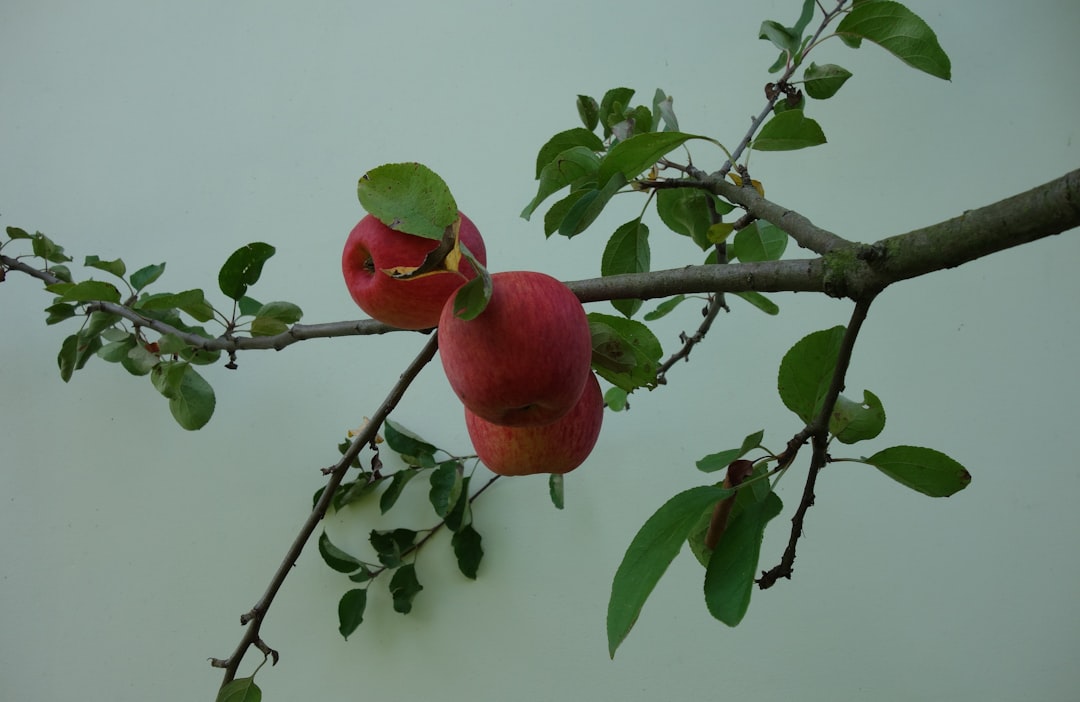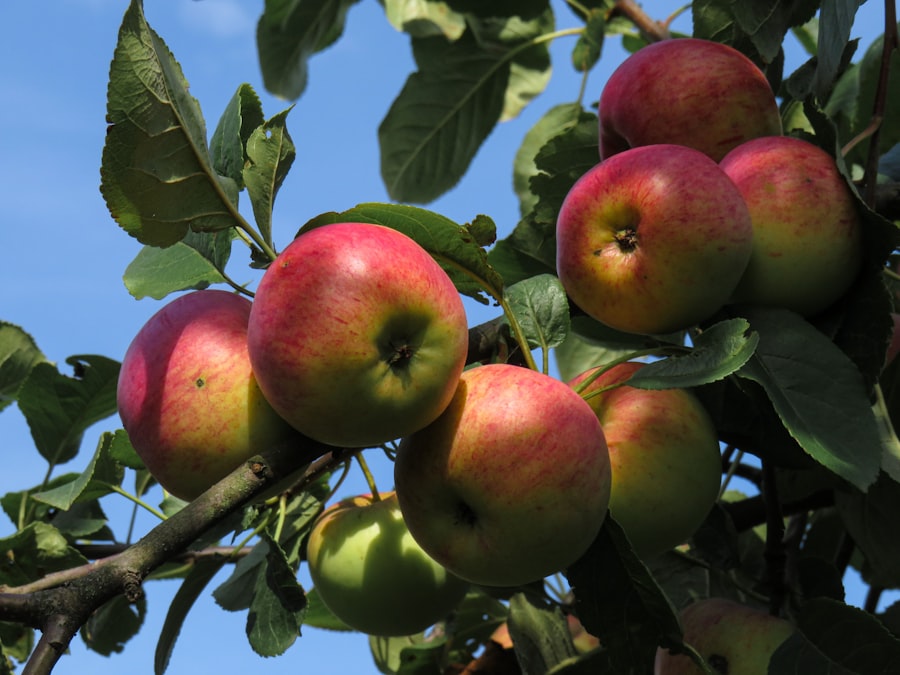When to Trim Your Apple Tree: A Guide

Pruning is an essential practice for maintaining the health and productivity of apple trees. By selectively removing branches and shaping the tree, pruning helps to improve air circulation, increase sunlight penetration, and promote the growth of new fruiting wood. In addition to these benefits, pruning also helps to prevent disease and pest infestations, as well as improve the overall appearance of the tree. In this article, we will explore the importance of apple tree pruning and provide tips and techniques for successful pruning.
Understanding the Importance of Apple Tree Pruning
Pruning apple trees offers a multitude of benefits. One of the main advantages is that it helps to control the size and shape of the tree. By removing excess branches and shaping the tree, you can prevent it from becoming too large or spreading too wide, making it easier to manage and harvest. Pruning also improves air circulation within the tree, reducing the risk of fungal diseases such as apple scab.
Another important benefit of pruning is that it stimulates new growth and increases fruit production. By removing old or unproductive branches, you allow more energy to be directed towards the development of new fruiting wood. Pruning also helps to thin out the canopy, allowing more sunlight to reach the inner branches and promote fruit ripening.
Signs That Your Apple Tree Needs Pruning
There are several visual cues that indicate your apple tree may need pruning. One common sign is when branches start to cross or rub against each other. This can cause damage to the bark and create entry points for pests and diseases. Another sign is when branches become overcrowded or tangled, preventing adequate air circulation and sunlight penetration.
Other issues that pruning can address include dead or diseased branches, water sprouts (vigorous vertical shoots that grow from the trunk or main branches), and suckers (shoots that grow from the base of the tree). Pruning can also help to shape the tree and remove any branches that are growing in undesirable directions.
Timing is Key: When to Prune Your Apple Tree
| Timing | Pruning Method | Benefits |
|---|---|---|
| Winter | Heavy Pruning | Stimulates new growth, improves fruit quality and size |
| Spring | Light Pruning | Removes dead or diseased wood, shapes tree for optimal growth |
| Summer | Minimal Pruning | Removes water sprouts and suckers, promotes air circulation |
| Fall | Avoid Pruning | Leaves tree vulnerable to winter damage and disease |
The best time to prune apple trees is during the dormant season, which is typically in late winter or early spring before new growth begins. Pruning during this time allows the tree to heal quickly and minimizes the risk of disease transmission. It is important to avoid pruning during periods of extreme cold or when the tree is actively growing, as this can stress the tree and inhibit its ability to heal.
When timing your pruning, there are several factors to consider. First, you should wait until the worst of winter has passed and the risk of frost has diminished. Pruning too early can expose the tree to cold temperatures and damage the newly pruned branches. Second, you should avoid pruning during periods of heavy rain or when the tree is wet, as this can increase the risk of disease transmission.
Different Seasons, Different Pruning Techniques
The techniques for pruning apple trees can vary depending on the season. In winter, when the tree is dormant, you can focus on removing dead or diseased wood, as well as any branches that are crossing or rubbing against each other. This is also a good time to shape the tree and remove any water sprouts or suckers.
In spring, after new growth has started, you can continue to remove any dead or diseased wood that may have been missed during winter pruning. You can also thin out the canopy by selectively removing some of the smaller branches to improve air circulation and sunlight penetration.
In summer, you can perform what is known as “summer pruning.” This involves removing any excess growth or water sprouts that have developed since spring. Summer pruning helps to maintain the shape and size of the tree and prevents it from becoming too dense.
In fall, after harvest, you can perform a light pruning to remove any dead or diseased wood and shape the tree. This is also a good time to remove any branches that may be obstructing pathways or structures.
Pruning Young Apple Trees for Optimal Growth

Pruning young apple trees is crucial for establishing a strong framework and promoting optimal growth. When planting a new apple tree, it is important to prune it back to a height of about 30 inches to encourage branching and stimulate new growth. This initial pruning helps to shape the tree and establish a strong central leader.
As the tree grows, you can continue to prune to maintain a balanced shape and remove any branches that are growing in undesirable directions. It is important to avoid heavy pruning during the first few years, as this can delay fruit production. Instead, focus on shaping the tree and removing any dead or diseased wood.
Pruning Mature Apple Trees for Maximum Yield
Pruning mature apple trees is essential for maintaining their health and maximizing fruit production. One important technique for pruning mature trees is known as “thinning.” Thinning involves selectively removing some of the fruit clusters to reduce competition and improve fruit size and quality. Thinning also helps to prevent branches from breaking under the weight of heavy fruit.
Another technique for pruning mature apple trees is known as “renewal pruning.” This involves removing old or unproductive wood to stimulate the growth of new fruiting wood. Renewal pruning helps to rejuvenate the tree and increase its overall productivity.
Tools You Need for Apple Tree Pruning
To successfully prune apple trees, you will need a few essential tools. These include hand pruners, loppers, a pruning saw, and a pole pruner for reaching higher branches. Hand pruners are used for cutting small branches up to 1/2 inch in diameter, while loppers are used for cutting larger branches up to 2 inches in diameter. A pruning saw is used for cutting larger branches, and a pole pruner is used for reaching branches that are out of reach.
When choosing pruning tools, it is important to select high-quality, sharp tools that are comfortable to use. Dull or low-quality tools can make pruning more difficult and increase the risk of injury. It is also important to clean and sanitize your tools before and after each use to prevent the spread of disease.
Safety Tips for Pruning Your Apple Tree
Pruning apple trees can be physically demanding and potentially dangerous, so it is important to take proper safety precautions. First, make sure to wear protective clothing, including gloves, safety glasses, and sturdy footwear. This will help to protect you from cuts, scratches, and falling debris.
Second, use caution when working on a ladder or climbing the tree. Make sure the ladder is stable and secure before climbing, and always have someone nearby to assist you if needed. Avoid overreaching or leaning too far while on the ladder, as this can cause you to lose your balance.
Finally, be mindful of your surroundings and avoid pruning near power lines or other hazards. It is also important to be aware of any wildlife or insects that may be present in the tree.
Common Mistakes to Avoid When Pruning Your Apple Tree
There are several common mistakes that can harm your apple tree if not avoided. One common mistake is known as “topping,” which involves cutting off the top of the tree to reduce its height. Topping can severely damage the tree and lead to weak growth and increased susceptibility to disease.
Another mistake is removing too much foliage or fruit during pruning. While it may be tempting to remove excess branches or fruit clusters, doing so can stress the tree and inhibit its ability to produce energy through photosynthesis. It is important to strike a balance between removing enough wood to promote growth and leaving enough foliage for photosynthesis.
Finally, it is important to avoid pruning during periods of extreme heat or drought. Pruning during these conditions can stress the tree and inhibit its ability to heal. It is best to wait until the weather has cooled down and the tree has had a chance to recover before pruning.
Hiring a Professional Apple Tree Pruner: Pros and Cons
While pruning apple trees can be done by homeowners, there are benefits to hiring a professional. One of the main advantages is that professionals have the knowledge and experience to properly prune trees and avoid common mistakes. They also have the necessary tools and equipment to safely and efficiently prune trees of all sizes.
However, there are also factors to consider when deciding whether to hire a professional. One factor is cost, as hiring a professional can be more expensive than doing it yourself. Another factor is time, as it may take longer for a professional to schedule and complete the pruning compared to doing it yourself.
Ultimately, the decision to hire a professional or do it yourself depends on your comfort level, budget, and time constraints. If you are unsure or have a large or complex tree that requires pruning, it may be best to consult with a professional.
Pruning is an essential practice for maintaining the health and productivity of apple trees. By selectively removing branches and shaping the tree, pruning helps to improve air circulation, increase sunlight penetration, and promote the growth of new fruiting wood. Pruning also helps to prevent disease and pest infestations, as well as improve the overall appearance of the tree.
When pruning apple trees, it is important to consider the timing, techniques, and tools needed for successful pruning. It is also important to take proper safety precautions and avoid common mistakes that can harm your tree. Whether you choose to do it yourself or hire a professional, proper pruning will help ensure the health and productivity of your apple tree for years to come.



